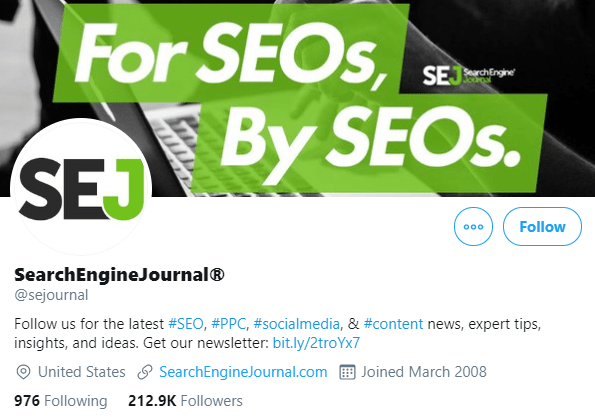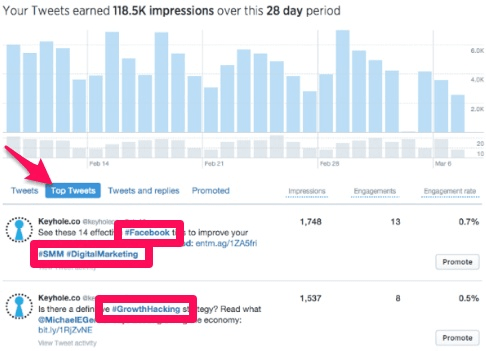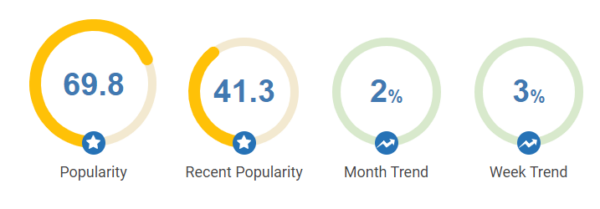Twitter is a powerful platform to build your personal brand as well as to strategically market your products and/or services. In this article, I will shed light on tips and strategies for marketing your brand effectively on Twitter.
While working with Hackr.io, I made Java tweet about Hackr.io. I have worked countless hours experimenting on what works on Twitter and what does not. I have done the hard work for you. Cheers!
It may take a while for you to start getting decent engagement on Twitter but once you get the feel of it, you are bound to spend more time on the platform.
If your brand already uses Twitter for marketing purposes, you will enjoy reading this Twitter marketing guide.
In this guide, I’ll focus on:
- How to optimize your Twitter profile?
- Who should brands follow on Twitter?
- What type of content should brands create on Twitter?
- How to engage with content posted by others on Twitter?
- How to use Twitter search for marketing your brand?
- How to leverage Twitter lists?
- The advantages of using Twitter Publish
- The importance of Twitter Cards
Let’s get started!
Twitter Marketing Tips
The following Twitter marketing strategies are tried and tested. Here’s what brands should do on Twitter:
How to optimize your Twitter Profile?
Before firing shots, work on your Twitter profile.
Your brand’s logo should be your Twitter account’s profile picture. Upload a cover image that portrays the value proposition of your brand. Don’t forget to write a short crisp description focusing on your unique selling proposition.
You can even include hashtags in the profile description for your brand to appear in the search results when someone searches for the hashtags you mentioned.
If your brand has partnered with a few notable players in the industry, mention their usernames in the profile description. Add a link to your website in the website field of your profile.
Having a short Twitter username is advantageous. If your brand has a short username, there are chances your band will be tagged/mentioned more often by users, influencers, and other brands.
Add your country as a location if you have customers from around the world or from your country. Add your city as a location if your customers are from your city.
Have a look at Search Engine Journal’s Twitter account. SEJ has optimized its account for reach, clicks, and profile views.
Image Source: Twitter
Here’s a cool hack to get more clicks from Twitter. Include a link in your profile bio. On Twitter, when someone hovers over an account, the bio of that account can be seen but not the website field. Try hovering on accounts to understand what exactly I mean!
Image Source: Twitter
Who should brands follow on Twitter?
A brand must have more number of followers than the accounts it follows. It’s like a social proof that the brand is valuable. It does not mean that brands do not follow back.
As a brand on Twitter, you should follow key influencers in your niche, the members of your team, your partners and collaborators, and other stakeholders.
When someone follows your brand’s account, go through their profiles to see if they are relevant. Follow back relevant accounts. Use a tool to unfollow accounts that unfollowed you after you followed them.
When you’re just starting out building your audience on Twitter, you need followers who will engage with your tweets. If you reverse engineer, non-followers that engage with your content will follow your brand if you follow them first.
Mention brands, influencers, and other stakeholders in your tweets so that they engage with your tweets. This way you can leverage their audiences. This trick is particularly useful for increasing your followers when you’ve just started building your presence on Twitter.
An important point to note when you’re following accounts is to not follow many accounts in one go. You don’t want your account to be rate-limited.
If you follow a large number of accounts and then unfollow them (manually or using automation) in an effort to inflate your followers, your account may get suspended!
If you see a message saying, “You are unable to follow more people at this time,” it could mean you’ve hit your daily follow limit (400 for non-verified accounts and 1000 for verified accounts), you followed too many accounts too fast, or you reached a follow ratio limit. In the worst case, your account might be locked or restricted.
Read more about Twitter rate limits and rules for following accounts here.
What type of content should brands create on Twitter?
When you’ve just started building your presence on Twitter, you do not need to tweet multiple times a day. Once or twice a day is enough. It’s about quality than quantity.
Twitter allows 280 characters per tweet. Create crisp valuable content, tag relevant accounts, include images and links.
If you’re attending a conference or an event, use their branded hashtag for additional visibility. Check out the top tweets in #DigiMarCon – a branded hashtag for the largest digital marketing, media and advertising conference & exhibition series in the world.
To increase the reach of your tweets, tag relevant accounts, and use relevant hashtags in your tweets. Use 1-2 hashtags per tweet. Tweets with 1-2 hashtags get 21% more engagement than those with three or more hashtags.
Image Source: SocialMediaToday
Let’s do some reverse engineering. Find your most important hashtags using Twitter Analytics and check out the top tweets for those. Replicate key characteristics of these top tweets.
Image Source: Keyhole
Use Hashtagify to find the best hashtags for your tweets before tweeting. Here’s the data from Hashtagify for the Twitter hashtag “#growthhacking”. Use those hashtags that are fairly popular and have a +ve percentage of the monthly and weekly trends.
Image Source: Hashtagify
One thing you must note that tweets with images get 89% more likes. Make sure to use relevant images only. Use tools like Canva and Piktochart for designing stunning visuals even if you do not have any prior design experience.
Image Source: Buffer
Images outperform text, but videos outperform images. Videos are 6 times more likely to be retweeted than photos and 3 times more likely to be retweeted than GIFs. With videos, you can give your tweets a longer lifespan. You can also go live on Twitter. The live streams are automatically posted as tweets when the stream ends.
Use GIFs in your tweets especially when replying to tweets posted by other accounts. I love using GIFs when replying to other people’s tweets. Who said that brands can’t use GIFs?
Polls work well on Twitter. Create polls and Fleets (Instagram-like stories that disappear after 24 hours) to engage with your audience even more.
Once you have attained a few followers (say 50 or 100), increase the frequency of your tweets. Who said you cannot tweet your previous tweet every week? But do this only if you are posting many tweets per week.
Tweet during peak hours. Tweets posted on Friday, Saturday, and Sunday have higher CTRs than those posted during other days of the week.
Image Source: Buffer
Your peak posting times will depend on your audience. Test how your tweets perform at different times and days. According to the time zone of your audience, tweet between 12 PM and 6 PM for maximum reach and engagement.
Use tools like Buffer or Hootsuite to schedule your tweets. Scheduling makes your life easier on Twitter especially if you have to post the same content again and again over the next few weeks.
Have you tried creating a tweet thread? It helps you curate your tweets. Create a tweet thread to make the audience aware of your previous tweets related to a topic. To create a thread, simply click/press the comment button on your previous relevant tweet and post your content.
Image Source: Twitter
How to engage with content posted by others on Twitter?
Now that we know what type of content works best on Twitter, it’s time we shift our focus to engaging with content posted by others.
A brand must engage strategically with tweets posted by industry influencers, customers, and other brands!
Strengthen your bond with the ones you follow by retweeting their tweets. Only retweet relevant tweets. Don’t forget to add your quote when retweeting. It increases the chances of your tweets getting retweeted.
Comment on relevant tweets posted by industry influencers showcasing your expertise. Make sure to comment as soon as the tweets get posted to have maximum impact.
It’s always a fun thing to engage with tweets of your competitors. IndiGo, India’s largest private airline, started the light-hearted conversation by poking fun at Vistara and other airlines hopped on to have some fun!
Image Source: India Today
Last but not least – be funny with your tweets! Here are a few brands that are nailing their Twitter engagement by just being funny.
Another strategy could be to engage with recent and top tweets in relevant hashtags. Your goal should be to provide value. Do not like, comment, or retweet many tweets in one go. Your account may get rate-limited.
Please do not use bots and other automation services for liking, commenting, and retweeting. Why would you risk losing your account?
How to use Twitter search for marketing your brand?
Let’s say the target audience for your brand is an SEO executive (like Semrush).
Search the term “SEO”. You’ll see something like this:
Just below the “People” section, you will see some tweets. Comment on these tweets – only relevant ones. Don’t comment something generic (like – good content, like it, etc). Add value to the tweet!
Why I’m asking you to comment on these tweets is because these tweets are getting more visibility as they are Top tweets for the term “SEO”.
If you want your target audience to check your brand out, like relevant and valuable tweets from the “Latest” tab.
Image Source: Twitter
This is one way of increasing your followers on Twitter. Do not like many tweets instantly. Twitter will think that you’re using automation for liking tweets and could possibly restrict your account from engaging with tweets.
As tweets containing photos and videos are retweeted more, make sure to comment on tweets from the “Photos” and “Videos” Search tab.
You can even filter accounts and tweets based on filters like – exact phrase matches, language, location, mentioning certain accounts, and more using the advanced search.
You can even find tweets containing links, posted within a date range, and having minimum k likes, comments, or retweets. Advanced search is powerful, isn’t it?
Ideal for finding partnership/collaboration prospects.
How to leverage Twitter lists?
Now that you’ve learned a few basic tricks to get the most out of Twitter, it’s time to deep dive into an advanced Twitter marketing strategy.
Twitter Lists!
Here’s how lists work on Twitter – add accounts to a list and see their tweets in the form of a feed that updates in real-time as and when new tweets are posted by the accounts on the list.
Here’s how the feed from my marketing list looks like:
Image Source: Twitter
Lists can be public and private.
From your brand’s Twitter account, create lists to curate content posted by relevant stakeholders.
You can create one list for influencers and bloggers, one for users who actively engage with your content, one for competitors to keep a track of their activities! The sky is the limit!
When you add an account to your public list, they get a notification.
You should add competitors to a private list.
See all my lists here.
Do you know why lists are magical? Because they can be embedded.
You can embed a list containing industry influencers on your brand’s website.
Your website’s visitors would be delighted to see real-time content curated by you for making them aware of the latest happenings, trends, resources, and more!
Now you understand the power of user-generated content?
The advantages of using Twitter Publish
You already know that Twitter lists can be embedded on your website or blog.
Using Twitter Publish, you can generate HTML codes for embedding your posted tweets, a single tweet, a profile (with a follow button), moments, tweets you’ve liked, tweets in a hashtag, and more!
Image Source: Twitter
If you visit my website from a desktop/laptop, you will see my recent tweets embedded.
It is common for brands to embed their tweets on their websites and blogs.
If you’re running a hashtag-based competition or discussion on Twitter, you can embed the hashtag on a relevant blog post or a relevant page on your website.
Check out Semrush’s Twitter account, they have a branded hashtag #semrushchat used for hosting weekly discussions.
Image Source: Twitter
Semrush asks queries by tweeting them out mentioning #semrushchat. Others reply to the queries by commenting on Semrush’s tweets or quote retweeting their tweets. It’s just another way to engage with your audience and build your fan following.
Image Source: Twitter
Semrush then retweets valuable tweets, curates top tweets from #semrushchat, and shares them with the audience as top tips for that particular query (like a roundup).
Image Source: Twitter
User-generated content is everywhere these days. As a brand, you must know how to leverage UGC.
Coming back to the topic. Semrush could embed its tweets in #semrushchat on a relevant page on their website or a blog post.
Do you now understand the power of UGC and embedding?
Just by embedding Twitter lists on a web page, I made a tool for viewing the latest tweets by Top Internet Marketers, Technology Influencers, and Serial Entrepreneurs in real-time. It’s called Tweet-Wall. Here’s how it looks like:
Image Source: vikaskalwani.com
The importance of Twitter Cards
If you want your web page to be displayed as a card when shared on Twitter, you’d need to implement Twitter Cards.
It just makes your web pages look visually appealing.
Using Twitter Cards, you can attach photos and videos to your tweets thereby driving traffic to your web pages.
There are 4 types of Twitter Cards that you can implement – a Summary card, a Summary card with a large image, an App card, and a Player card.
The Summary card is the most commonly used card. It creates a card with a title, description, and thumbnail.
If you share my website on Twitter, this is what you will see:
Image Source: Twitter
Brands should implement Summary cards for all of their website pages to drive more traffic from Twitter.
The Player card displays video, audio, or media. Here’s how a Player card looks like:
Image Source: Twitter
The App card lets brands drive installs to their apps from Twitter. It can even deep-link into the mobile app.
Note that App cards only show on mobile devices. Here’s how an App card looks like:
Image Source: Twitter
The App card shows the app’s name, price, ratings, and a short description. The call-to-action only shows in the Twitter for iPhone, iPad, and Android apps – only if the user has not installed the app.
Here’s the official guide to Twitter Cards.
Let’s say you have added the HTML codes to your web pages. How do you check if they work or not?
Simply enter the URL (after implementing the card) in the Card Validator tool.
Image Source: Twitter
Wrapping Up
Twitter is an amazing platform to market your brand organically. Not only can you generate traffic from Twitter, but also leads and user-generated content. Not to forget, Twitter plays a significant role in online reputation management. Make Twitter a vital part of your brand’s marketing strategy in 2021.
This article was originally published here (on Vikas Kalwani’s blog).
Read more:




















